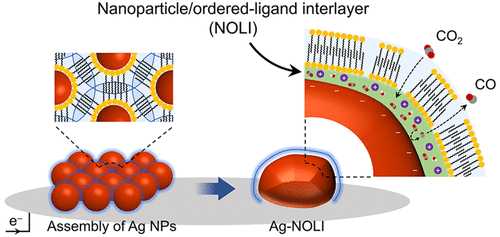当前位置:
X-MOL 学术
›
J. Am. Chem. Soc.
›
论文详情
Our official English website, www.x-mol.net, welcomes your
feedback! (Note: you will need to create a separate account there.)
Nanoparticle Assembly Induced Ligand Interactions for Enhanced Electrocatalytic CO2 Conversion
Journal of the American Chemical Society ( IF 14.4 ) Pub Date : 2021-11-16 , DOI: 10.1021/jacs.1c09777 Sunmoon Yu 1, 2 , Dohyung Kim 1, 2, 3 , Zhiyuan Qi 2 , Sheena Louisia 2, 3 , Yifan Li 2, 3 , Gabor A Somorjai 3, 4 , Peidong Yang 1, 2, 3, 5
Journal of the American Chemical Society ( IF 14.4 ) Pub Date : 2021-11-16 , DOI: 10.1021/jacs.1c09777 Sunmoon Yu 1, 2 , Dohyung Kim 1, 2, 3 , Zhiyuan Qi 2 , Sheena Louisia 2, 3 , Yifan Li 2, 3 , Gabor A Somorjai 3, 4 , Peidong Yang 1, 2, 3, 5
Affiliation

|
The microenvironment in which the catalysts are situated is as important as the active sites in determining the overall catalytic performance. Recently, it has been found that nanoparticle (NP) surface ligands can actively participate in creating a favorable catalytic microenvironment, as part of the nanoparticle/ordered-ligand interlayer (NOLI), for selective CO2 conversion. However, much of the ligand–ligand interactions presumed essential to the formation of such a catalytic interlayer remains to be understood. Here, by varying the initial size of NPs and utilizing spectroscopic and electrochemical techniques, we show that the assembly of NPs leads to the necessary ligand interactions for the NOLI formation. The large surface curvature of small NPs promotes strong noncovalent interactions between ligands of adjacent NPs through ligand interdigitation. This ensures their collective behavior in electrochemical conditions and gives rise to the structurally ordered ligand layer of the NOLI. Thus, the use of smaller NPs was shown to result in a greater catalytically effective NOLI area associated with desolvated cations and electrostatic stabilization of intermediates, leading to the enhancement of intrinsic CO2-to-CO turnover. Our findings highlight the potential use of tailored microenvironments for NP catalysis by controlling its surface ligand interactions.
中文翻译:

纳米粒子组装诱导配体相互作用增强电催化 CO2 转化
催化剂所处的微环境与决定整体催化性能的活性位点一样重要。最近,已经发现纳米颗粒 (NP) 表面配体可以积极参与创造有利的催化微环境,作为纳米颗粒/有序配体中间层 (NOLI) 的一部分,用于选择性 CO 2转换。然而,许多被认为对形成这种催化夹层至关重要的配体-配体相互作用仍有待理解。在这里,通过改变 NPs 的初始尺寸并利用光谱和电化学技术,我们表明 NPs 的组装导致 NOLI 形成所需的配体相互作用。小 NP 的大表面曲率通过配体叉指促进相邻 NP 的配体之间的强非共价相互作用。这确保了它们在电化学条件下的集体行为,并产生了 NOLI 结构有序的配体层。因此,使用较小的 NP 可以产生更大的催化有效 NOLI 面积,这与去溶剂化的阳离子和中间体的静电稳定有关,2 -to-CO 周转率。我们的研究结果强调了通过控制其表面配体相互作用,定制微环境在 NP 催化中的潜在用途。
更新日期:2021-12-01
中文翻译:

纳米粒子组装诱导配体相互作用增强电催化 CO2 转化
催化剂所处的微环境与决定整体催化性能的活性位点一样重要。最近,已经发现纳米颗粒 (NP) 表面配体可以积极参与创造有利的催化微环境,作为纳米颗粒/有序配体中间层 (NOLI) 的一部分,用于选择性 CO 2转换。然而,许多被认为对形成这种催化夹层至关重要的配体-配体相互作用仍有待理解。在这里,通过改变 NPs 的初始尺寸并利用光谱和电化学技术,我们表明 NPs 的组装导致 NOLI 形成所需的配体相互作用。小 NP 的大表面曲率通过配体叉指促进相邻 NP 的配体之间的强非共价相互作用。这确保了它们在电化学条件下的集体行为,并产生了 NOLI 结构有序的配体层。因此,使用较小的 NP 可以产生更大的催化有效 NOLI 面积,这与去溶剂化的阳离子和中间体的静电稳定有关,2 -to-CO 周转率。我们的研究结果强调了通过控制其表面配体相互作用,定制微环境在 NP 催化中的潜在用途。










































 京公网安备 11010802027423号
京公网安备 11010802027423号